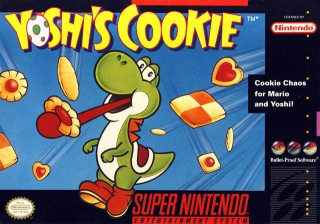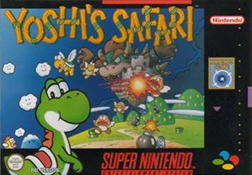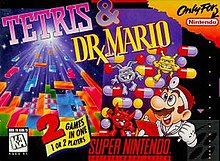
Super Mario Kart is a kart racing game developed and published by Nintendo for the Super Nintendo Entertainment System (SNES). The first game in the Mario Kart series, it was released in Japan and North America in 1992, and in Europe the following year in 1993. Selling 8.76 million copies worldwide, the game went on to become the fourth best-selling SNES game of all time. Super Mario Kart was re-released on the Wii's Virtual Console in 2009, on the Wii U's Virtual Console in 2013, and on the New Nintendo 3DS's Virtual Console in 2016. Nintendo re-released Super Mario Kart in 2017 as part of the company's Super NES Classic Edition.

Dr. Mario is a 1990 puzzle video game developed and published by Nintendo for the Nintendo Entertainment System, Famicom, and Game Boy. It was produced by Gunpei Yokoi and designed by Takahiro Harada. The soundtrack was composed by Hirokazu Tanaka.

Yoshi's Cookie is a 1992 tile-matching puzzle video game developed by Tose and published by Nintendo for the NES and Game Boy platforms in 1992. A Super NES version was released the following year, developed and published by Bullet-Proof Software.

Tetris Attack, also known as Panel de Pon in Japan, is a puzzle video game developed by Intelligent Systems and published by Nintendo for the Super Nintendo Entertainment System. A Game Boy version was released a year later. In the game, the player must arrange matching colored blocks in vertical or horizontal rows to clear them. The blocks steadily rise towards the top of the playfield, with new blocks being added at the bottom. Several gameplay modes are present, including a time attack and multiplayer mode.

Wario's Woods is a puzzle video game developed by TEC and published by Nintendo for the Nintendo Entertainment System. It was released in Japan and North America in 1994 and Europe in 1995. A spin-off of the Mario series, players control Toad in his mission to defeat Wario, who has taken control of the Peaceful Woods. Gameplay revolves around clearing each level by using bombs to destroy groups of enemies. The game also features a multiplayer mode that allows two players to compete against each other.

Yoshi, known as Mario & Yoshi in PAL regions, is a puzzle video game developed by Game Freak and published by Nintendo. It was released for the NES and Game Boy platforms. Both versions were first released simultaneously in Japan on December 14, 1991, and released in all other regions the following year.

Yoshi's Safari is a 1993 light gun shooter developed and published by Nintendo for its Super Nintendo Entertainment System (SNES). It is the only Mario franchise game to feature first-person shooter gameplay and requires the SNES's Super Scope light gun. As Mario and his pet dinosaur Yoshi, the player embarks on a quest to save the kingdom of Jewelry Land from Bowser and his Koopalings, who have kidnapped its rulers and stolen 12 gems. The game features 12 levels in which the player shoots enemies like Goombas and Koopas, and collects power-ups and coins. At the end of each level, the player engages in a boss fight with an enemy, a Koopaling, or Bowser. Nintendo commissioned its R&D1 department to develop Yoshi's Safari in response to the waning popularity of the Super Scope. Yoshi's Safari was the first Super Scope title to use the SNES's Mode 7 graphics mode, and the future of the peripheral depended on the game's performance.

Pokémon Puzzle League is a puzzle video game in the Puzzle League series developed by Nintendo Software Technology and published by Nintendo for the Nintendo 64. Released in North America on September 25, 2000, and in Europe on March 2, 2001, its Puzzle League-based gameplay has a focus on puzzle-based strategy in the game's grid-based format. To advance to new levels, players are required to combat the game's trainers and gym leaders, similar to the ones featured in Pokémon Red, Blue, and Yellow. One of several games based on the Pokémon anime, it features lead protagonist Ash Ketchum, his Pikachu, his companions Brock and Misty, the Kanto Gym Leaders, and other characters from the series.

Dr. Mario 64 is a tile-matching action puzzle video game developed and published by Nintendo for the Nintendo 64. The game was released in North America on April 9, 2001. The game is an enhanced remake of Dr. Mario, which was originally released for the NES and Game Boy consoles in 1990, and is based around characters from the 2000 Game Boy Color game Wario Land 3. The game's soundtrack was composed by Seiichi Tokunaga, featuring arrangements of classic Dr. Mario tunes and new compositions.

Pac-Attack, also known as Pac-Panic, is a 1993 falling-tile puzzle video game developed and published by Namco for the Super Nintendo Entertainment System and Sega Genesis. Versions for the Game Boy, Game Gear and Philips CD-i were also released. The player is tasked with clearing out blocks and ghosts without them stacking to the top of the playfield — blocks can be cleared by matching them in horizontal rows, while ghosts can be cleared by placing down a Pac-Man piece that can eat them. It is the first game in the Pac-Man series to be released exclusively for home platforms.

Tetris DS is a puzzle video game developed and published by Nintendo. It was released for the Nintendo DS on March 20, 2006, in North America, April 13, 2006, in Australia, April 21, 2006, in Europe, and April 27, 2006, in Japan. An installment of the Tetris franchise, the game supports up to ten players locally, and supported online multiplayer of up to four players using Nintendo Wi-Fi Connection prior to its discontinuation.

Tetris is a puzzle video game developed and published by Nintendo for the Game Boy in 1989. It is a portable version of Alexey Pajitnov's original Tetris and it was bundled with the North American and European releases of the Game Boy itself. It is the first game to have been compatible with the Game Link Cable, a pack-in accessory that allows two Game Boy consoles to link for multiplayer purposes. A remaster, Tetris DX, was released on the Game Boy Color in 1998. A Nintendo 3DS Virtual Console version of Tetris was released in December 2011, lacking multiplayer functionality. The game was released on the Nintendo Switch Online service in February 2023.

Planet Puzzle League, known as Puzzle League DS in Europe, and as Panel de Pon DS in Japan, is a video game for the Nintendo DS handheld video game console in the Puzzle League Panel de Pon visual matching puzzle game series. In North America, Planet Puzzle League is part of the Touch! Generations brand; in Japan, Panel de Pon DS is marketed in the general Touch! brand. The publisher for the game is Nintendo, and the developer is Nintendo's second-party developer Intelligent Systems, creator of the original Panel de Pon and its cult classic English-language adaptation Tetris Attack. The game was released in Japan on April 26, 2007 in North America on June 4, 2007, and in Europe on June 29, 2007.

Dr. Mario Online Rx, stylized as Dr. Mario Online ℞ and released in PAL regions as Dr. Mario & Germ Buster, is a puzzle video game starring Dr. Mario. It was one of the WiiWare launch games in Japan, Europe, and Australia, and was released in 2008 on March 25 for Japan, on May 20 for Europe and Australia, and for North America on May 26.

Tetris Party is a puzzle video game by Hudson Soft for WiiWare. An installment of the Tetris series, the game supports the use of Miis and the Wii Balance Board, and features both local and online multiplayer in addition to several single-player modes unique to the game.

Dr. Mario Express, known in PAL regions as A Little Bit of... Dr. Mario, is a Mario action puzzle video game published by Nintendo. The game was released as a DSiWare title for the Nintendo DSi platform. Dr. Mario Express was released as a launch title for the DSiWare service in Japan on December 24, 2008, and was released in both North America and PAL regions in 2009. The game was developed by Arika, which had also created Dr. Mario Online Rx for WiiWare.

A tile-matching video game is a type of puzzle video game where the player manipulates tiles in order to make them disappear according to a matching criterion. In many tile-matching games, that criterion is to place a given number of tiles of the same type so that they adjoin each other. That number is often three, and these games are called match-three games.

Dr. Luigi is a 2013 puzzle video game developed by Arika and Nintendo SPD, and published by Nintendo for the Wii U console. It is the sixth game in the Dr. Mario series and is part of the larger Mario franchise. The player must clear a field of invading viruses using pill capsules to eliminate them, in a tile-matching fashion. The game offers four modes: "Operation L", which utilizes L-shaped pills; "Virus Buster", using the Wii U GamePad and touchscreen; "Retro Remedy" with standard Dr. Mario gameplay; and local and online multiplayer options, online utilizing the soon to be defunct Nintendo Network Service.

Tetris 2, known in Japan as Tetris Flash, is a puzzle video game developed by Nintendo and Tose and published by Nintendo for the Nintendo Entertainment System. It was ported to the Game Boy in 1993 and Super Nintendo Entertainment System in 1994 by Bullet Proof Software.

Dr. Mario World was a 2019 match-three mobile game developed and published by Nintendo in collaboration with Line Corporation and NHN Entertainment.





















